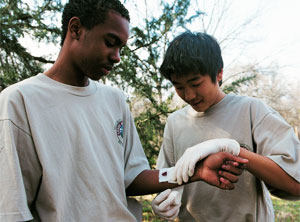How to treat a knife cut
 Q: What do you do for a knife cut?
Q: What do you do for a knife cut?
A: Great question! Truth is, the answer to your question is probably more about what you do NOT do with a knife cut, and you’ll see why…
Accidental knife cuts — called lacerations — are rarely life threatening. So the goals in the backcountry are to:
- Minimize infection
- Promote healing
- Decrease the need for evacuation
The first thing you should do with any laceration is calm the victim and, when possible, elevate the injured part of the body as much as possible above the victim’s heart. Protect yourself by wearing non-permeable first-aid gloves and good eye protection.
Next, stop the bleeding. This is best accomplished by applying direct and constant pressure to the wound using a wadded sterile compress, cloth, or — if need be — direct hand-to-wound contact (that’s why you “gloved up”). Hold pressure for a full 10 to 15 minutes. If you sneak a peek and still see bleeding, then the clock resets and you bought yourself another 10 to 15 minutes. Try at least 2 full rounds of direct pressure before considering a pressure bandage, tourniquet or other more extreme measures.
With the bleeding stopped, take a closer look at the injury. Check the pulses in the area of the wound; they should be strong and regular. The surrounding tissue should be warm and pink. There should be no loss of sensation, and motor function should be fully intact. In general, any differences that are noted when compared to the uninjured side of the body suggest the possibility of a more serious injury. In these cases, immediate medical attention by healthcare professionals should be the top priority.
Now, you have to clean the wound to prevent infection. An old saying in surgery goes, “The solution to pollution is dilution.” For minor wounds in the backcountry setting, this means washing away the dirt and bacteria from within the wound itself. Use the cleanest disinfected liquid available. The best irrigants are normal saline, disinfected water or fresh tap water. Avoid using povidone iodine (Betadine), rubbing alcohol, and hydrogen peroxide, which can cause further tissue damage.
The irrigation stream has to have enough force behind it to dislodge any foreign material without injuring the tissue underneath, and you have to be careful not to jam harmful material deeper into the wound. The goal is not to soak the wound but to clean it thoroughly. Try to use at least 1 liter of irrigation fluid to clean each wound.
When possible, bandage a laceration with a dressing that does not stick to the wound. Non-adherent dressings include Telfa, Xeroform, Adaptic and Aquaphor. You can apply an antiseptic ointment such as bacitracin to the surface of the wound before bandaging if you have it. When bandaging, be careful to allow for continued assessment of vital signs and function.
Be sure to keep up-to-date on your tetanus shots before you embark on a trip into the wilderness, and always seek professional medical attention as soon as possible!
This is helpful 🥳
i got cut….. ow
I got cut today, its not bleeding but how do i protectif from getting infect when my family are out of badiges
I accidentally stabbed my right forearm with a very sharp pointed knife.it looks like it needs stitches in my opinion. If I use butterfly stitches, will it close up)
i got cut. i dont have badinages, its not bleeding, but how do k provent a infection
working on leather merit badge need help with safety requirement
It is nice
Thanks for the update
😉😀
I hate knives they hurt LOL
me too
very helpful this helped alot i was scared
Cut my finger about 3cm deep this helped got 5 stiches